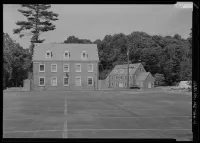Share what you know,
and discover more.
Share what you know,
and discover more.

-

- Marley Zielike
Robert B. Morse Water Filtration Plant, 10700 and 10701 Columbia Pike, Silver Spring, Montgomery County, MD
Constructed by the Washington Suburban Sanitary Commission and opened in 1936, the Robert B. Morse Water Filtration Plant is significant for its unique filter assembly designed by Chief Engineer Robert B. Morse. Rather than locating the steps of the filtration process (sedimentation, flocculation, filtration and storage) in separate structures, Morse designed a filter assembly that incorporated nearly all the steps into one circular structure. Although the filter assemblies were removed after the plant was taken offline in 1962, elements of the filtration process remain. The site is also significant in the history of the development of municipal water systems, both in the Washington, D.C., metropolitan region and in the United States.
Robert B. Morse Water Filtration Plant, 10700 and 10701 Columbia Pike, Silver Spring, Montgomery County, MD
Constructed by the Washington Suburban Sanitary Commission and opened in 1936, the Robert B. Morse Water Filtration Plant is significant for its unique filter assembly designed by Chief Engineer Robert B. Morse. Rather than locating the steps of the filtration process (sedimentation, flocculation, filtration and storage) in separate structures, Morse designed a filter assembly that incorporated nearly all the steps into one circular structure. Although the filter assemblies were removed after the plant was taken offline in 1962, elements of the filtration process remain. The site is also significant in the history of the development of municipal water systems, both in the Washington, D.C., metropolitan region and in the United States.
Robert B. Morse Water Filtration Plant, 10700 and 10701 Columbia Pike, Silver Spring, Montgomery County, MD
Constructed by the Washington Suburban Sanitary Commission and opened in 1936, the Robert B. Morse Water Filtration Plant is significant for its unique filter assembly designed by Chief Engineer Robert B. Morse. Rather than locating the steps of the filtration process (sedimentation, flocculation, filtration and storage) in separate structures, Morse designed a filter assembly that incorporated nearly all the steps into one circular structure. Although the filter assemblies were removed after the plant was taken offline in 1962, elements of the filtration process remain. The site is also significant in the history of the development of municipal water systems, both in the Washington, D.C., metropolitan region and in the United States.Posted Date
Sep 27, 2021
Source Name
Library of Congress
Source Website
Delete Story
Are you sure you want to delete this story?


